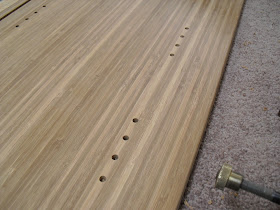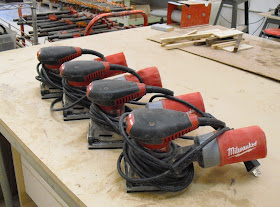A Delta Q3 variable speed scroll saw was recently donated to my shop, hopefully to be used by someone in need of it.
The people who work in my shop like to try out different tools, so I thought it would be a good idea to keep it around the shop for a while, to see if anyone wanted to use it for their projects. A few people tried it out, for some simple marquetry experiments, but they moved on. It's a shame; it's a very nice tool that was sort of going to waste.
Now, I have to say, this tool came to me used. I have no idea how many hours were spent on it, or what the previous owner cut with it. And since I generally work on on a larger scale, I didn't have much need for this saw. But let me tell you - the Delta Q3 variable speed scroll saw is one pretty nice machine. Not one I would have purchased for my work, but very nicely designed.
First of all it is extremely sturdy. You can tell just by putting your hands on the table and flipping on the power. Negligible vibration, solid power. It has a large table that can accommodate nice sized pieces, with enough room for you to guide the work while cutting. The fellow who donated this saw to my shop included a mobile base with it. That's a really nice feature if you have a small space and need the mobility.
It is also extremely easy to use. Changing the blade is simple. Even my mother could do it. (No offense, Mom!) The blade is held in place with a clamp. All you do is open the clamp, remove the blade, insert another blade and tighten the adjustment screw. Look! No hands!! Well, a little use of the hands is good.
An artist/friend of mine, who works with copper, has been trying to figure out a better way to cut shapes in metal without having to use a jeweler’s saw or snips. The copper she uses is about 1/8” thick. And she likes to work large. So working with a jeweler’s saw isn’t really cutting it for her. She also tried a jigsaw but the couldn’t hold the metal firmly enough while maintaining cutting. When I saw the Delta Q3 in action, I immediately thought of her. It would be perfect for cutting metal! Yes, the Delta Q3 Variable Speed Scroll Saw can cut metal. All you have to do is change the blade to a metal cutting blade and I think this tool will do the trick. And with the large table, she can easily maneuver the metal and obtain the shapes she wants.
Now, the drop. My friend lives in New Mexico. About eight hours away. So we've decided to meet half-way between New Mexico and Las Vegas, in Flagstaff. It will be a long day, but getting this tool to a good owner is important.
Oh - by the way, my friend is the artist who did all of the cool paintings in my shop - like this giant tape measure
and this
and these.
Here is some math for you to ponder: 8 hour drive round-trip + a nice meal with a friend + a $300 tool donation = +/- $500.
Seeing the countryside + listening to my iPod + seeing my friend = Priceless.






















































